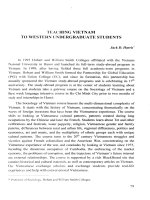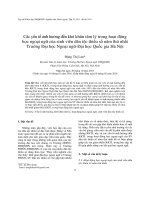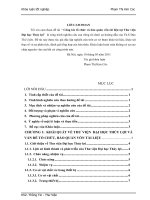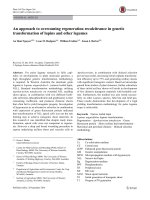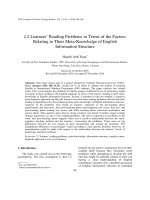DSpace at VNU: Theoretical approach to single - mod operation of bistable fabry - perot laser comtaining staturable absorber
Bạn đang xem bản rút gọn của tài liệu. Xem và tải ngay bản đầy đủ của tài liệu tại đây (2.25 MB, 7 trang )
VNU JOURNAL OF SCIENCE, Mathematics - Physics. T . XVIII, N()2 - 2002
T H E O R E T I C A L A P P R O A C H T O S IN G L E - M O D E
O P E R A T IO N O F B I S T A B L E F A B R Y - P E R O T
L A S E R C O N T A I N IN G S A T U R A B L E A B S O R B E R
Phung Quoc Bao, Dinh Van Hoang
DrpHJ't inrnt o f P h y sics, C o liecg e o f Scien ce - V N Ư
A bstract: A theoretical approach to the optical bistability ( O B ) effect in singlemod ( Fabry- Perot lasers co n ta in in g saturable absorber ( L S A ) is presented on the
basis o f the rate equations until allowance f o r spontaneous e m is s io n and spatial holebu rn ing . Special attention IS paid to the case o f dom in an t in h om ogcncous broadening
in hoth L o trn iz ia n and G a u ss ia n models. The influence o f the m a in LS A p a ra m
eters on O B occM Tcncr c o n d itio n s as well as on o n c u r v e s ' ch a ra cteristics are
invrstiyatf'd in detail.
M;ul<‘ to operate in two stable low and high o u tp u t levels corresponding to the
unsaturaĩod and strongly saturated states of the intracavity absorber, a laser containing
saturablo nbsoilxT (LSA) mav exhibit a hysteresis cycle of photon density versus laser
pumping power (see [1-4 . for instance). This bistable operation results from the* combined
effect of th<* saturable absorber and the feedback provided by the optical cavity itself. The
OB iratun'S ai'(‘ therefore (lepriiilrnt not only on the LSA parameters but on the cavity
geometry of LSA as well. Recently, in [5-7] has been performed a system atic analysis for
( )B of dominant inlioinogencouslv broadened ring LSA. This paper is devoted to investigate
thf‘ OB hrhfivinr of Fabry - Perot LSA when th e inhomogcueous atom ic linowidth greatly
cxcrrds I hr homogeneous one. Both Lorentzian and Gaussian laser pumping rate profiles
are takon into account in tilt* rate (‘q uations w ith allowance for spontaneous omission and
spatial liolr hurtling.
Our LSA model consists of a pianar-mirror Fabry - Perot resonator of length L.
(lin'd t‘(i iiloiit» the ./-axis, containing tho amplification and absorption cells with the same
length I fit th<* coordinates ./•„ and Xfo, n'spectively. Both amplifier arid absorber are
consi< l
<)t Lorrntziiui honiogrnrously broadened with the same h a l f - w i d t h r. The inhomogeneous
gain profile' of half-width f centered at fîo is composed of a continuous distribution of
homogeneous packets at frequencies . We consider the case where the cavity can sustain
only ou r mode» of photon num ber 77, with circular frequency iij = njiijC/L (nij integer,
r velocity of light.) at a detuning A j — Ii l j — Í2()|. For simplicity, we assume the cavity
losses Xj in this mock' to hr constant. In the rate equation approximation, such a system
obeys the following equations:
+ 2 h B ( n j + 1) J i / K
^
= R,ta - \hBg{ ư t ấ
-
Q j)rij
1
+
- n , ) [ N ' ; a - A ft],
la ) N
^
(l.a)
(lb)
Phung Quoc B a o , D in h Van Hoang
<*Ki
- = ỉĩ,,b - \ h B g { u tl - ũ 3 ) n 3 + 7fc]^b
dt
with ì i ~ 3/4.
Here I ỉ is the Einstein coefficient and
s '" ' Njlị —
(1 G)
—í ì j ) can ho. generally roprcsíMitrd hy ỉì
= P Ị IK
-
(2)
Nfti — N fiij are effective population differences in both media with:
[ X'+2
N
/
n
r, f)f/:r and A'
d.r
J*i-±
(3)
(here / stands for a or 6).
U fiaiX jt) and Tiv b(x, t) are the densities of population differences between the atomic
upper and lowor levels ill both media. 7 a and
denote the relaxation rates of I hr upper
levels in the amplifying and absorbing atoms, respectively.
In the Lorentzian model, the laser pumping rate R ^ a with the pumping rale* constant
R q can be expressed as follows:
ĩỉụu —Rị)
(4)
..
2
€2 -f 4(u>,4 -
As for the Gaussian model, it can be written as:
p
,
= c?/?0 exp
4(0/^ - «o)a In 2
with G' = V 7TIn 2
(5)
The absorber-pumping rate R fli, is assumed to be constant.
The calculations in detail show that, this rate equation approximation is easily justi
fied in the case of steady-state operation near threshold when the photon number in Fahi v
- Perot LSA is not larger than 4.1011 .
Sorting the time derivatives
:ives in Eqs.(l) equal to zero and evaluat ing the sum OVCT //
by the transformation .givon below
plow [5]:
£ ' < “■ > 4 Í Í
ỉ { ư ) d u>
((i)
'j fn «
/•iti'.jf i m i '
wo obtain the Lorentzian steady-state
equation:
c> -
(Q + Ĩ ) \
....... ..........
g
-V1 ) y i T hQAi + < » /T T 3 j + i s ỵ i - a ự m f j )I
_
iự n
i,Q ,/ị
= 0
(7)
and the Gaussian one:
B
Qj ~
4 ( q .1 + 7
Gn0ReW{2Sj y/ng + ta y/( 1 + fiQj ) In 2)
V/71 4- h Q j
0.
s V l+
(8)
3
T h e o r e tic a l a p p ro a c h to s in g le -m o d e o p e r a tio n o f...
13
„
if I '
V V ỈH T C Q j
I
n i o í Ị ỉ‘ i n t e n s i t y
w it h
7
— 7a :
...I
I
S- Uisrr
„ pumping Mtr:
-----7 Vj
£ - — - sat unit io:i coefficient;
>
a — - inlio of homogeneous to ill homogeneous broadening;
Z
n { j)
ÍT/, —
------- —
1
- a b so rb e r
p u m p in g
r a t (>;
\ ./
(5. —- - detaining scaled to the inhomogeneous half-width.
f
U‘(,:) - the rrror iunction of complex argument z - which is defined by [8]:
W( z )
<*X|>(
z~)tjr f c ( —i z ) w i t h e r f c . ( —i z ) = 1 H—
7= s I
V ^ Vo
c" r (it.
(9 )
Slightly above tin* la.KiT threshold. Eqs. (7) and (8) can be approximated bv a cubic
equat ion of tIlf* form:
(loQ'j + n ỵQ j2 + n o Q j + a.i = u,
( 10)
whore:
i/o
//“[( 1 I 2 mv)(l — 4bS j) 4-8bỗ 2ị]
'2 h {\( I
(L\
mv)( 1 -f- £) 4- tt£a](l - 4òổj) *f 8ÒỔ^(1 4* £)} + ...
••• + - y W K I + 2 aor)(l - 4bỗ?) + Sbỗj} - G ơ 0 }
a2
(4£ + ri-rr/,)[( 1 + ci(x)(l — 4 W j) + 86(5^] - a£Gơo
íỉ;ị --<> — {<7/4(1 ỉ a a )(l — Abỗ2:) -1- 8 bỗ'*] — £ G ơq }
1
with a
I) -
1 for the L o m it/ia n pumping profile and a £3 0.95,6 % - 0 .8 0 for the
Gaussian pumping profile.
The nun»(*ri< al analysis of Eq.(10) shows that at a given Sj, for a appropriate control
parameter set (£ ,o \ ƠỊ,). the* OB may occur in a certain range of laser pumping rate Ơ0
confined between ơ()Jìt and ƠQXỊ. By definition, the OB curve’s characteristics are ÜB
onset value Ơ0mt OB width (the difference ƠQM —% n ) and OB height (the LSA photon
intensity ai Ơ()A/).
Ill resonance' (Sj
0), for given values of (£<*), 1 1 0 OB action is observed until
the absorber pumping ratr miches a minimum value (Tbm• Increasing ơ I,, the typical fullshaped OB curve is shifted towards the higher laser pum ping rates, a t the same time i t ’s
size get larger. Just as ƠỊ, goes beyond a critical value ơbtĩ a portion of the OB lower branch
becomes negative, thus physically meaningless, and hence the OB curve is partly truncated
away. Further increasing ơf,, tho truncated OB curve is always displaced towards higher
<70, the OB height grows continuously, hut the effective OB width remains constant. The
resonant OB phiiso diagram divides the ( £ ,a ) p aram eter plan into three domains (from
left to right): mono-Stabl(\ bistable, and truncated bistable (Fig.l).
Phung Quoc B a o , D inh Van H oang
4
Fig. i.Lorentzian OB phase
diagram in resonance
(ỗj — 0, solid lines,
in non-resonance (ỎJ = 0.294, dotted lines)
In non-resonance (ỎJ Ỷ 0), for given values of
there exist also the two critical
absorber pumping rates ơỊ)rn and ơbt- However, the more the LSA is detuned, the smaller
the possible full-shaped OB parameter region ơbt - ơf)Tn. Moreover, as ƠỊ, increases past
ơbt, the effective OB width diminishes quickly and vanishes at a certain value ơ b o Ị / •
The OB action is off. The larger the detuning
the more rapidly the effective OB
decreases. The non-reasonable OB phases diagram divides now the (£,cv) parameter plan
into four domains: monostable, bistable, truncated bistable and OB-off (F ig .l). NVarly
the same size in resonance, the Lorentzian OB parameter domains reduce more quickly
than the Gaussian ones by increasing the detuning 6 j . The OB width variations for a set
of values (£,<*) in both resonant and non-resonant Gaussian LSA are depicted in Fig/2.
The Gaussian OB width is always smaller than the Lorentzian one of the same parameter
set.
F ig . 2 .Lorentzian (solid lines) and Gaussian (dotted lines) OB width variations
for £ = 0.25, a = 0.016 at various detuning values
T h e o r e tic a l a p p r o a c h to s in g le - m o d e o p e r a tio n o f..
5
To perform the linrar stability analysis of thế' steady-state solutions 'HisyNỊĩas ail
n ,ụ) -
I u
N ' ; j t ) = NỊ'lliS + ,ìụưe ~ Xi N ;f b(t) = A% s +
.
(11)
Linearizing the obtained equations with respect to the assumedly real fluctuations
Vj ' fifta 1 7hih' w<‘ arrive' at a system of linear homogeneous algebraic equations. In order
that there exists i\ nontrivial solution, the associated determinant should vanish:
(let(.4 f X I ) = 0
(12)
where / is the unity matrix and A - a matrix with the following elements:
- i l j ) { N * a - 1\ % ) 1s ; a 12 = —Û13 = ----- — y ----- |.s
«11 “ - \ j 1 2 h D Y
«21
- - B j i 7 V / 'fJ.s ; « 2 2
-
— B g rijft
-
7 ;
«23 -
0
«31 = - M y t h s ' «32 = 0: rt-tt - - B g r i j s - £ 7 ,
hrre 7/ is the average value within the frequency range of 2 r centered at fij. And this
furnishes ail equation for À:
A* - 6 2 A2 + M - fc(, = 0,
(13)
fro — «12^21 ttflH “ ^11^22^33 — ^12^21^31
ỏl — Qịọíìo 2 +
1)2 — — ( o \ \
^22^33
^12^31 — Û12^91
4- r; 22 + <*33 ) •
According to the expanded Roulh - Hurwitz theorem, all the real parts of the roots
A, of Eq.( 13) are positive, that, implies Ỉ he corresponding steady-state solutions are stable,
provided that
/>0
> (),/>]6.2 —b o > 0 and f>2 > 0 .
The stability of the resonant hysteresis curves is numerically chocked with XJ —
10’ 2s ~ \ B = 10 Vs 1 and 7
l()8.s“ 1 [5]. Some results are displayed in Fig.3. The
point and plus (or ./• for Gaussian curves) marks represent, unstable and stable solutions,
respectively. The whole middle branch is always unstable, whereas the lower and upper
branches steadily exhibit. the stability for every set of parameter values. This is not the
case in resonant ring LSA where* there may exist an instability section on the OB upper
branch just after the turning point [7].
For given
Ị,) in th(‘ bistable phase dom ain, the stab ility analysis o f the noil-
resonant steady-state solutions shows that there exists a certain detuning at which a
section of the OB uppor branch, just after the turning point, becomes unstable. The more
the LSA is det.mi(*cl. the more the instability section extends towards higher pumping rates
(Fig. 4). The critical detuning for (£ = 0.25,a = 0.16,ơfe = 40) is about 0.075 and 0.148
in Lorentzian and Gaussian LSA, respectively. For t he sam e set (£,<*) as before, we fix at
Sj = 0.176 and carry out the stability analysis of the truncated OB curves with various
Phung Quoc B a o , D inh Van Hoang
6
ơ h. By increasing ơị,. the OB curves are more and more truncated hi It still remain the
same stability properties as ill resonance (Fig. 5).
e
T
0ỊM>01Õ'"7
X
n T iv o o ií
7
♦
/I
/
X
• •
5...................
•........ ...... - ■
: ..........
X
X
•
*
X
> . 4 ................. V .................. >•••• K-
I
sI 3
•
- .................... > .................... .
*
♦ ..................
:
Ỉ i
i *
:
*
:
:
:
0 art too
OWWBO—T.......r*........V
j! ?
2.... f*0.2SW
:::|Ịị:|:Ẹ :r::
10 2Ằ
?0
50i
I 30L0 — J50
J
00 450
LASERPUMPIN4G
RATE
50C550
Fifl. 5. St ability of resonant Lorentzian ( + ) and Gaussian (x) OB curves
for <76 = 40 at various sets of (i/tt)
F i g . 4 -Stability of non-resonant. Lorentzian ( + ) and Gaussian (x) OB curves
for £ = 0.25, a = 0.016, CĨỊ, — 40 at various detuning values
..... ........ I........i*”
I«r...... >.......>.-/■•
*
:X
t I2h........ ..........V....
*
i 10
5
ị «
I.
bo
il'oV»ni--- —
600
700
1«I-i-i-* --—---- - i'mÌ»1iiiiiJ
aoo
000 1000
LASERPUMPINGRATE
1100
1200
F i g . 5 .Stability of non-resonant truncated Lorentzian (+ ) and Gaussian (x) OB curves
for £ = 0.25,0: = 0.016 at various absorber pumping values
T h e o r e tic a l a p p r o a c h to s in g le - m o d e o p e r a tio n o f..
We have presmird a theoretical approach to OB behavior of single-mode Fabrv IVrot LSA with dominant Lorontzian/Gaussian in homogeneous broadening in both res
onance and uon-rcsíniainv cases. Th<‘ control parameters conditions for OB occurrence
more strict as soon as LSA is (let lined. Oner OB occurred, one can onlargr the OB
curvr’s shcipr l>y ( lioosinji small £ and largo
At high values of (7ị,. OB curves may
havo ri tnincnW'd lunn. The linear stability analysis ill resonant LSA has shown two of
thi’CM* stoady stale solutions arc always stable and no instability on the OB upper branch
is observed. This five's rise to a full hysteresis loop of the photon density versus the lasOr
pumping rate*. When til»' LSA is (iotunrd by an amount large enough, there appears an
u|>p
havr a larger OB parameter region, a .smaller OB onset value and higher control efficiency.
Furthermore, Gaussian hysteresis curves are more stable against accidental changes of the
LSA detuning. From the practical viewpoint, a Gaussian resonant LSA may be the most
favorable to OB operation as far as the used approximation holds.
References
1. R. Millier, z . P h y sik B- C o u d a is . M a tte r , 40(1980), 257.
2. L. A. Lugittto and L. .VI. Xan'lmri. Phys. R e v .y A32(1985), 1576.
II. I). Dangoisst*. p. Glorieux and I). Hennequin., Phys. Rev. A42(1990). 1551.
4. Dinh Van Hoang and Tran Thi Thu Ha. Inf. Phys. 32(1991), 75.
5. Pilling Quoc Bao and Dinh Van Iloang, Proc. o f 7th A s ia P a c ific Phys. Conf.,
Beijing. China. 1997. 445.
(). Phung Quoc Bao and Dilih Van Hoang. C om m , in Phys., CNST, 8. No. 1(1998),
33.
7. Dinh Van Hoang and Phimg Quoc Bao, Proc, o f 2th Nat. Conf. on O ptics and
Spectroscopy. Thainguyen, Vietnam, 1998.
8. M. Ahramowitz and I. Stegun. Handbook o f M athem atical F u n c t io n s , Dover. Now
York, 1972.
T A P CHÍ KHOA HOC ĐHQGHN, Toán - Lý. T XVIII. So 2 - 2002
M Ộ T C Á C H TỈỂ P CẬN LÝ T H U Y Ế T V Ề H O Ạ T Đ Ộ N G Đ Ơ N M O D E
LUỒNG Ổ N ĐỊN H C Ủ A L A SER F A B R Y - P E R O T
CH ỨA CH Ấ T HẤP T H Ụ BẢ O HOÀ
P h ù n g Q u ốc Bảo, Đ inh V ân H oàng
Khoa Vậĩ ly. D ạ i học Khoa học T ự nliiên - Đ H Q G H à N ộ i
Bài báo trình bày một cách tiếp cận lý thuyết hiệu ứng lưỡng ổn định quang học (OB)
trong laser Fabry - Perot đơn mode, chứa chất hấp thụbâo hoà (L SA ) dựa trẽn gần đúng
phương trình tốc độ có tính đến bức xạ tự phát và sự tạo hốc không gian. Các trường hợp
mờ rộng không đồng nhất dạng Lorentz và dạng Cỉauss được đặc biệt chú ý. Anh hường
của các tham số LSA lên điẽù kiện xuất hiện cũng như lên đặc trưng cùa đường cong lưỡng
ổn định được nghiên cứu chi tiết.
